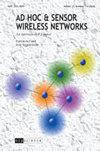Improving the Realism of the Physical Layer of NS-3 by Considering the PAPR Problem of the IEEE 802.11p Transmitter
IF 0.6
4区 计算机科学
Q4 COMPUTER SCIENCE, INFORMATION SYSTEMS
引用次数: 1
Abstract
NS-3 is a network simulator used for the research and development of Vehicular Ad-hoc Networks (VANETs). It allows the IEEE 802.11p standard simulation, which is part of IEEE Wireless Access in the Vehicular Environment (WAVE). One of the limitations of the 802.11p standard in NS-3 is using a simplified theoretical model of the Packet Error Rate (PER). This standard uses for the Physical Layer (PHY) the Orthogonal Frequency Division Multiplexing (OFDM) technique, which suffers from high Peak to Average Power Ratio (PAPR). This high PAPR of the signal causes degradation of the PER when it passes through a non-linear amplifier. In this work, we study the effect of the high PAPR over the PER using a MATLAB implementation of the 802.11p PHY. We also analyze the effect of using the Orthogonal Pilot Sequences (OPS) technique for PAPR reduction. The results show that the high PAPR affects the PER of high data rates, which use 16-QAM and 64-QAM modulation. Finally, these results are extended to NS-3 simulations as a new model of the IEEE 802.11p PHY with high realism since it considers the effect of the non-linear HPA. The NS-3 results show a similar trend compared to the MATLAB simulations.考虑IEEE 802.11p发射机的PAPR问题提高NS-3物理层的真实感
NS-3是一个用于研究和开发车辆自组织网络(VANETs)的网络模拟器。它允许IEEE 802.11p标准模拟,这是IEEE车载环境无线接入(WAVE)的一部分。NS-3中802.11p标准的限制之一是使用了简化的分组错误率(PER)理论模型。该标准在物理层(PHY)中使用正交频分复用(OFDM)技术,该技术的峰值与平均功率比(PAPR)较高。当信号通过非线性放大器时,高PAPR会导致PER的退化。在这项工作中,我们使用MATLAB实现802.11p PHY来研究高PAPR对PER的影响。我们还分析了使用正交导频序列(OPS)技术降低PAPR的效果。结果表明,高PAPR会影响采用16-QAM和64-QAM调制的高数据速率下的PER。最后,将这些结果扩展到NS-3仿真中,作为IEEE 802.11p物理层的新模型,由于考虑了非线性HPA的影响,具有较高的真实感。NS-3仿真结果与MATLAB仿真结果具有相似的趋势。
本文章由计算机程序翻译,如有差异,请以英文原文为准。
求助全文
约1分钟内获得全文
求助全文
来源期刊

Ad Hoc & Sensor Wireless Networks
工程技术-电信学
CiteScore
2.00
自引率
44.40%
发文量
0
审稿时长
8 months
期刊介绍:
Ad Hoc & Sensor Wireless Networks seeks to provide an opportunity for researchers from computer science, engineering and mathematical backgrounds to disseminate and exchange knowledge in the rapidly emerging field of ad hoc and sensor wireless networks. It will comprehensively cover physical, data-link, network and transport layers, as well as application, security, simulation and power management issues in sensor, local area, satellite, vehicular, personal, and mobile ad hoc networks.
 求助内容:
求助内容: 应助结果提醒方式:
应助结果提醒方式:


